Review of DRAWING RESTRAINT Exhibition in San Francisco
by Mark Burbey
 The exclusive U.S. staging of Matthew Barney’s DRAWING RESTRAINT Exhibition opened on June 23rd at the San Francisco Museum of Modern Art, successfully bringing visitors closer to Barney’s work than any of the hype ever could. The exhibition “occupies the Museum’s entire fourth floor, which has been reconfigured to eliminate the gallery walls and so encourage a nonlinear experience of the art.” This ambitious project spans nearly 20 years and includes film, video, sculpture, illustration, and performance, with an over-arching visual vocabulary that serves as the connective tissue between each of the aforementioned media. This overview of Barney’s on-going project is impressive not only in vision, but in execution. The creative process is as thematically vital to Barney’s work as the art itself, and monitors displaying video loops of the work as endeavored under purposefully challenging and restrictive conditions function both as documentation and performance.
The exclusive U.S. staging of Matthew Barney’s DRAWING RESTRAINT Exhibition opened on June 23rd at the San Francisco Museum of Modern Art, successfully bringing visitors closer to Barney’s work than any of the hype ever could. The exhibition “occupies the Museum’s entire fourth floor, which has been reconfigured to eliminate the gallery walls and so encourage a nonlinear experience of the art.” This ambitious project spans nearly 20 years and includes film, video, sculpture, illustration, and performance, with an over-arching visual vocabulary that serves as the connective tissue between each of the aforementioned media. This overview of Barney’s on-going project is impressive not only in vision, but in execution. The creative process is as thematically vital to Barney’s work as the art itself, and monitors displaying video loops of the work as endeavored under purposefully challenging and restrictive conditions function both as documentation and performance.
Many of the large scale sculptures in the exhibit reflect images and moments in DRAWING RESTRAINT 9. A scene in the film of a pier that collapses under the weight of an unspecified object being pulled from the water is replicated in a sculpture of the pier as rubble, impressively and weightily executed from wood, steel, concrete, petroleum jelly, and self-sealing plastic. In an adjoining and much larger room, accented with the ambience of icy winds and storm-whipped seas (similar to the tonality of Björk’s “Storm” from the DR 9 soundtrack), are sculptures of ice flows. Video monitors showing related scenes from the film hang from the ceiling. In other rooms are smaller sculptures made from similar materials, such as the bench
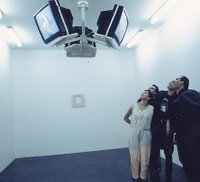 with the whaling tools, and the three multi-channel video installation created for DRAWING RESTRAINT 7, showing Barney as a hairless satyr and a Cadillac driving through an unending tunnel as two smaller satyrs wrestle in the backseat. Still other rooms hold small illustrations framed in self-sealing plastic and photos clipped to metal clipboards.
with the whaling tools, and the three multi-channel video installation created for DRAWING RESTRAINT 7, showing Barney as a hairless satyr and a Cadillac driving through an unending tunnel as two smaller satyrs wrestle in the backseat. Still other rooms hold small illustrations framed in self-sealing plastic and photos clipped to metal clipboards.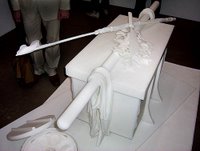 inability of some to see beyond the hype surrounding Barney’s celebrity. There is no shortage of precedents within the art world of artists who have used themselves in their work. Art is always about the artist, and the imagery in Barney’s work speaks for itself. Appreciating it on a visceral level alone doesn’t necessitate grasping its meaning, a truism that can be applied to the work of many artists.
inability of some to see beyond the hype surrounding Barney’s celebrity. There is no shortage of precedents within the art world of artists who have used themselves in their work. Art is always about the artist, and the imagery in Barney’s work speaks for itself. Appreciating it on a visceral level alone doesn’t necessitate grasping its meaning, a truism that can be applied to the work of many artists. Beyond affording the opportunity to view Barney’s work in person, the highpoint of the exhibition was the screening of DRAWING RESTRAINT 9. That the screening was included with the entrance price of $12.50 was a bargain in itself, and the fact that the audience was comprised of Barney and Björk fans guaranteed a relatively respectful viewing experience.
Beyond affording the opportunity to view Barney’s work in person, the highpoint of the exhibition was the screening of DRAWING RESTRAINT 9. That the screening was included with the entrance price of $12.50 was a bargain in itself, and the fact that the audience was comprised of Barney and Björk fans guaranteed a relatively respectful viewing experience.My review of the film would be more in line with that written for the NY Times by Stephen Holden (posted here on April 9, 2006), with a minor variance in opinion.
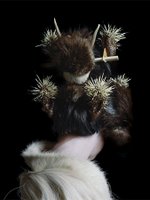 My one complaint is that Björk’s role in the film could have been played by anyone. That aside, if it had to be anyone, it's fabulous that it is Björk, but unlike the emotional connection she made with the audience as Selma in DANCER IN THE DARK, her appearance in DR 9 is buried alive beneath the solemnity of the film. She certainly looks fantastic as she sheds one set of garments to be adorned in another and then another, but little of what makes Björk so unique was allowed to emerge.
My one complaint is that Björk’s role in the film could have been played by anyone. That aside, if it had to be anyone, it's fabulous that it is Björk, but unlike the emotional connection she made with the audience as Selma in DANCER IN THE DARK, her appearance in DR 9 is buried alive beneath the solemnity of the film. She certainly looks fantastic as she sheds one set of garments to be adorned in another and then another, but little of what makes Björk so unique was allowed to emerge.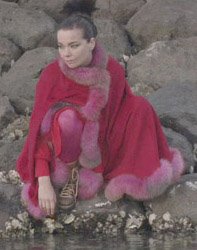 CREMASTER films, and it relies more on the symbolism of ceremony. This is not to say that the film is without its awesome and occasionally stunning imagery. The film takes place on various levels of a Japanese whaling vessel called the Nisshin Maru, and the least interesting portions of the film are those featuring Barney and Björk. The gravely formal sequences in which they prepare for and take part in a traditional Shinto wedding ceremony commit the capital crime of being boring to the point of inducing sleep, simply because all emotion or even a suppressed hint of giddy expectation is smothered beneath what we’re left to assume is the Japanese way.
CREMASTER films, and it relies more on the symbolism of ceremony. This is not to say that the film is without its awesome and occasionally stunning imagery. The film takes place on various levels of a Japanese whaling vessel called the Nisshin Maru, and the least interesting portions of the film are those featuring Barney and Björk. The gravely formal sequences in which they prepare for and take part in a traditional Shinto wedding ceremony commit the capital crime of being boring to the point of inducing sleep, simply because all emotion or even a suppressed hint of giddy expectation is smothered beneath what we’re left to assume is the Japanese way. Far more interesting are cut-aways to the ships’ crew working on a large sculpture prepared from petroleum jelly to Barney’s specifications, the retrieval of a large log-like item from the sea (which was on display in the exhibition), and female pearl divers. Things finally get interesting when the ship enters a storm, and water (or liquefied petroleum jelly) begins to flood the lower decks, where Barney and Björk become engaged in a grisly ritual of transformation. Despite the film’s length of 153 minutes, the film is too engaging to notice, even with the sleepy wedding segment.
Far more interesting are cut-aways to the ships’ crew working on a large sculpture prepared from petroleum jelly to Barney’s specifications, the retrieval of a large log-like item from the sea (which was on display in the exhibition), and female pearl divers. Things finally get interesting when the ship enters a storm, and water (or liquefied petroleum jelly) begins to flood the lower decks, where Barney and Björk become engaged in a grisly ritual of transformation. Despite the film’s length of 153 minutes, the film is too engaging to notice, even with the sleepy wedding segment.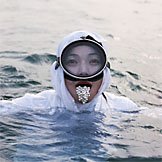
Influences: Matthew Barney
Your mother was an artist. What kind of art was in your home in
She was studying at that time. A lot of the things she was doing were done at school. But there were books lying around — Robert Smithson, Joseph Beuys, Eva Hesse.
And then you came to
She was living in Tribeca, and a lot of the things we would do were downtown. There were galleries in the
What kinds of movies did you watch growing up?
Horror films, for sure. The Evil Dead films, the Friday the 13th films, Jaws, The Omen, The Exorcist, The Shining—the simpler, the better. When I started making art, I think the simple-format horror films were a model for me, as a way of making something that blended an object and its environment—if you accept that in some of these stories the antagonist and environment are interchangeable, like the cabin-in-the-woods stories, or the ocean and the shark in Jaws. On a visceral level there was a big difference for me between “wet” characters and “dry” characters. Zombie films never appealed to me because they were too “dry.” I was repulsed by the lack of moisture in those characters.
Besides Ursula Andress, whom you cast in Cremaster 5, which actors made an impression on you? 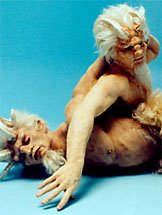 Bruce Campbell, in the Evil Dead films. It had to do with physical comedy.
Bruce Campbell, in the Evil Dead films. It had to do with physical comedy.
What about some of the other genres of film that show up in your work—thirties musicals, silent movies, Westerns?
There was a program on public television that had to do with particle theory and self-organizing systems, and they were taking images from some of those Busby Berkeley [films], and I remember relating to that very much. That might have been when I was in college [at Yale]. As a high-school student I spent quite a lot of time looking at film footage of myself playing football—we’d study these films after we played. They were silent, and they had a very odd presence.
What about art films?
The early video artists—Chris Burden, Vito Acconci, Bruce Nauman, Joseph Beuys, Marina Abramovic—were really influential. In many cases, I never saw the videos. As a student, I had access to still images. The relationship between those secondary documents and the primary event ended up influencing the way I use video: trying to document a primary action and create a secondary form out of it.
What did you read?
I remember liking Where the Wild Things Are very much. But when I started focusing on sports, I read less and less. It was quite natural for me to gravitate toward a physical way of learning, and I think I continue to
do that.
Speaking of physical challenges, you’ve long been obsessed with Harry Houdini. What do you consider his most impressive feat?
At the Hippodrome, he made an elephant disappear onstage. And of course the escape through the hole in the ice, which is in that film with Tony Curtis. I think because of that film we have an understanding of how that stunt worked, but I read somewhere recently that they checked the weather records in
How did you get to know the work of Richard Serra [who plays the patriarchal architect in Cremaster 3]?
Maybe it was Tilted Arc; I also remember shows at Castelli. I was thinking about the way the body develops under resistance—the way one tears down muscle cells in order to grow more of them. As an athlete, you take that for granted, but I was thinking about the way aesthetic form could develop as well. His thrown-lead pieces were a formalization of that, in a way: a violent action that’s crystallized immediately in the form. And the form is sublime.
How would you describe your relationship to the performing arts?
I’m a real tourist. I was working on Cremaster 3 with those showgirl characters, and I was trying to get my head around that language by going to musical theater—Fosse, the Christmas Spectacular. Opera is potentially the most perfect form, but I’ve never seen one that I really liked. I’m satisfied just sitting in the opera house, not understanding what’s going on.
How about pop music—what did you listen to before you met Björk?
Wendy O. Williams and the Plasmatics. Some of the first shows I saw when I moved to
In “The Order,” from Cremaster 3, you turn the Guggenheim into a kind of video game—are you a gamer?
I played the first wave of arcade games as a teenager—Galaxian, Pac-Man. Donkey Kong is one of those “levels” games I certainly thought about. Recently, I played a game that excited me—Grand Theft Auto. I was editing in
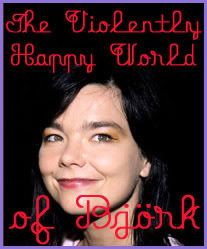
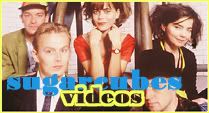


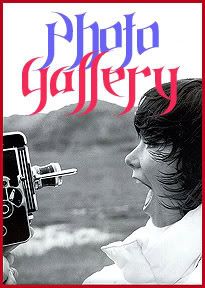
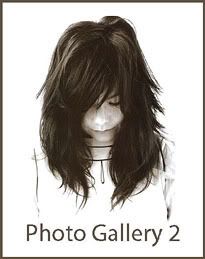
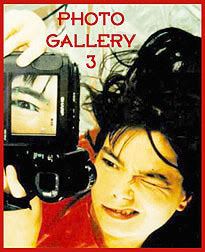
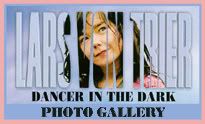

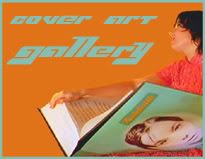

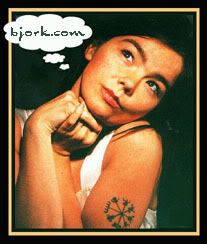
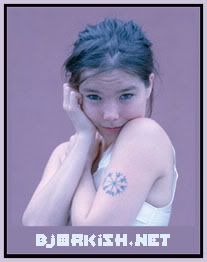

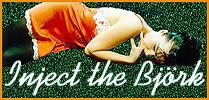

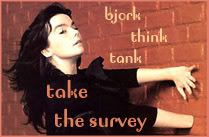



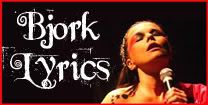
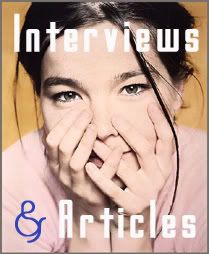
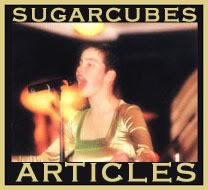





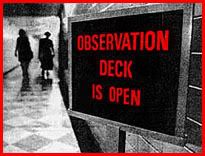



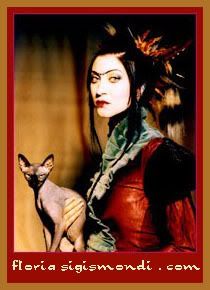



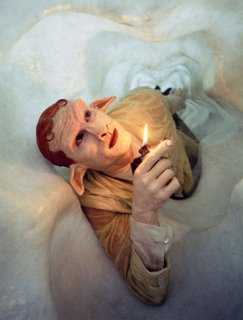



2 Comments:
Thanks for sharing this review Private Tutor Greater Heights
Thats a nice review Private Tutor Bouldin Creek
Post a Comment
<< Home